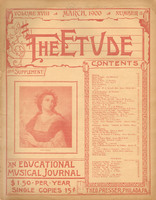BY W. F. GATES.
One of the first things that is apt to meet the teacher as he is talking to a prospective pupil is the question: “What method do you teach?” And if the teacher is a conscientious man or woman it is an awkward question to meet; for if he has pursued his work with some one teacher that has a label tagged on to his plan of work, and can say he teaches the “Jones” method, or the “Krause” method, or the this or the that method, while this may be true, he is pretty safe in assuming that the questioner knows nothing about the matter and only wishes to seem to be informed, and that it would be useless for pupils even of Deppe or Baif,—people who did have methods, to mention their teachers or their methods, as they would be equally unknown.
On the other hand, if this teacher has come to realize that this cry about method is largely an advertising scheme on the part of certain teachers and their pupils,—if he has simply reached out in an eclectic way to grasp, understand, retain, and practice the best points that have been given him by perhaps half a dozen good teachers, and adds to this the results of years of experience and reading,—if his “method” is simply the survival and application of the fittest, then he knows that the statement of this fact to the pretended seeker for information would be so much time and breath wasted. For Professor Smash (who has lately vanished from the town, in memory dear to many creditors) “told me himself that he began to study the fortissimo method when he was only two years old, and practiced it in his cradle, and when he began to teach at six years of age he always taught the fortissimo method, and that this was the method that Batch and Sour and all the rest of the great players used.”
You may use in your teaching the best points of Deppe, Raif, Mason, or Virgil and all the rest of the technicians; but if you haven’t got a big red label to put on it or flag to float over it, you cannot satisfy the stout dowager in search of a teacher of a “Method.”
And she will not have to go far to find the “method.” For there is always some one near who is willing to accommodate her with a name, especially after finding out what she wants and then telling her that is the method he teaches.
Then there are some teachers that really think they have a method; that is to say, have a plan of teaching, of technic especially, that is different from what is used by the common herd; something that no one else knows or can use but the originator and his pupils’ pupils down unto the seventy-seventh generation. It is surprising, but some of them do really believe this. Whereas, they have nothing in their teaching that is not used by any good teacher of common sense and good judgment, and probably lose much that such teachers have at their tongues’ end.
Tying one’s self down to one method, so called, is apt to have a narrowing influence on the teacher. He thinks that a thing is good because So-and-So says it is, not because he has tried it for himself; not because he has compared it in his practical experience with the plans and methods of others.
Let one know all he can about one method, if he can find one that really deserves the name, and then let him learn all he can of other people’s ways of doing things. And by this plan of weighing and comparing and giving practical trials he can choose for himself the things that seem best. Then he has a good method. But it lacks one point. It lacks a name. And a name is everything in the eyes of some people, and not only some, but a good many. Well, call it “Common Sense Method” to yourself and you will be about right.
But that name will not do for the public. “What’s in a name?” No, that is too simple, too sensible. “Common Sense Method” won’t do for the general public. They must have some fancier, some less understandable name. So for them, or such of them as I mentioned above, you will have to say, “My dear madam, I am an exponent of the great and only Docimastico-Dioristic Method of pianoforte spieling,—the world-famed method used by me and Beethoven, to say nothing of Liszt and the other lesser lights. It contains the summum bonum of all other so-called methods. You see it, madam, personified in me. And you will be fortunate to have the instruction of one who is among the last of the exponents of the true method. Yet, madam, I am yours to command (at $3.00 per hour).”
And you will probably get her. That’s what she wanted. But you got a fool for a pupil. What does she get for a teacher?



